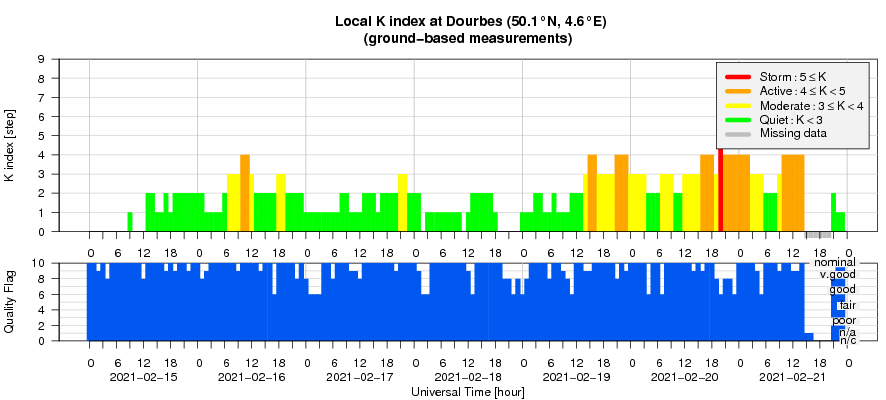- Table of Content
- 1.One CME a day....
- 2.Review of sola...
- 3.PROBA2 Observa...
- 4.The Internatio...
- 5.Review of geom...
- 6.Geomagnetic Ob...
- 7.The SIDC Space...
- 8.Review of iono...
2. Review of solar activity
3. PROBA2 Observations (15 Feb 2021 - 21 Feb 2021)
4. The International Sunspot Number by Silso
5. Review of geomagnetic activity
6. Geomagnetic Observations at Dourbes (15 Feb 2021 - 21 Feb 2021)
7. The SIDC Space Weather Briefing
8. Review of ionospheric activity (15 Feb 2021 - 21 Feb 2021)
One CME a day... keeps the SWx forecaster busy!
A quick look at the coronagraphic images obtained by the SOHO/LASCO instrument (https://sohowww.nascom.nasa.gov/ ) revealed a number of coronal mass ejections (CMEs) over the last few days. The figure underneath shows the CMEs on 20 (upper left), 21 (upper right), 22 (lower left) and 23 February (lower right) as seen by the wide-field LASCO/C3 instrument. The last 2 CMEs were the result of respectively a weak filament eruption near the southeast solar limb, and some eruptive activity just behind the northwest solar limb. None of these CMEs were directed to Earth. In the imagery, the bright spot on the right is the planet Venus heading for its superior conjunction with the Sun on 26 March (in plain English: Venus will be exactly at the opposite side of the Sun as seen from Earth). Movie clips are available in the online version of this newsitem at https://www.stce.be/news/515/welcome.html
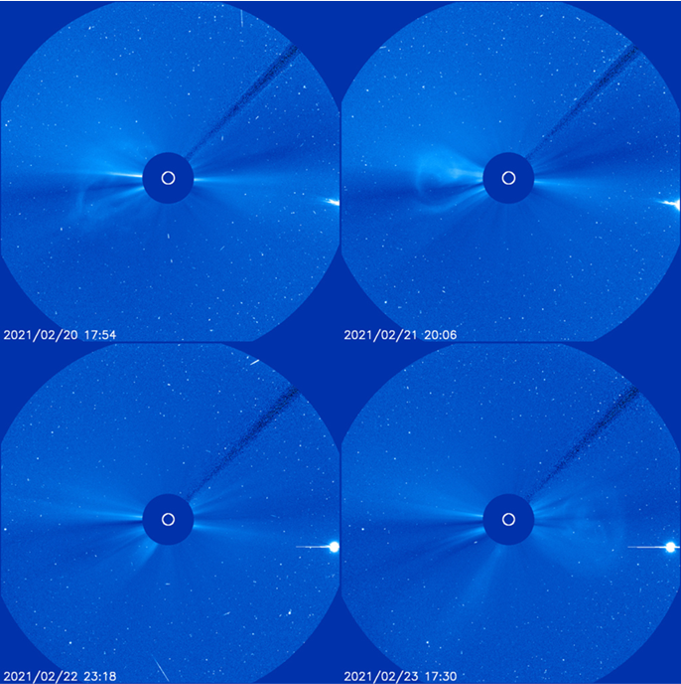
Solar filaments are clouds of ionized gas above the solar surface squeezed between magnetic regions of opposite polarity. Being cooler and denser than the plasma underneath and their surroundings, they appear as dark lines when seen on the solar disk and as bright blobs when seen near the solar limb (then they are called "prominences"). Filaments can appear in e.g. sunspot regions, but they can also appear completely isolated on the solar disk. In the latter case, they can become very long and last for one or more solar rotations. Pending the stability of the surrounding magnetic regions, the longer filaments (15 degrees or longer) eventually may erupt. This is what happened on 20 February, when a 25-degrees long filament in the southern solar hemisphere close to the central meridian erupted. With the Space Weather JHelioviewer (http://swhv.oma.be/user_manual/ ), SDO/AIA 193 images (temperatures of 1.3 million degrees) were combined with SDO/AIA 171 images (700.000 degrees) into a single clip showing the behavior of the Sun's outer atmosphere. The pre- and post eruption images clearly show the presence of parallel ribbons and coronal dimming, indicating that particles have been ejected into space (see the annotated version online). The associated CME was first observed by LASCO/C2 at 11:24UT. It was relatively wide (about 170 degrees, also called a "partial halo") and though the bulk of the CME seemed to be directed behind the Earth, there were some indications that the CME had an earth-directed component. Sure enough, solar wind data from early on 24 February indicated that the earth environment has indeed received a glancing blow from this interplanetary CME.
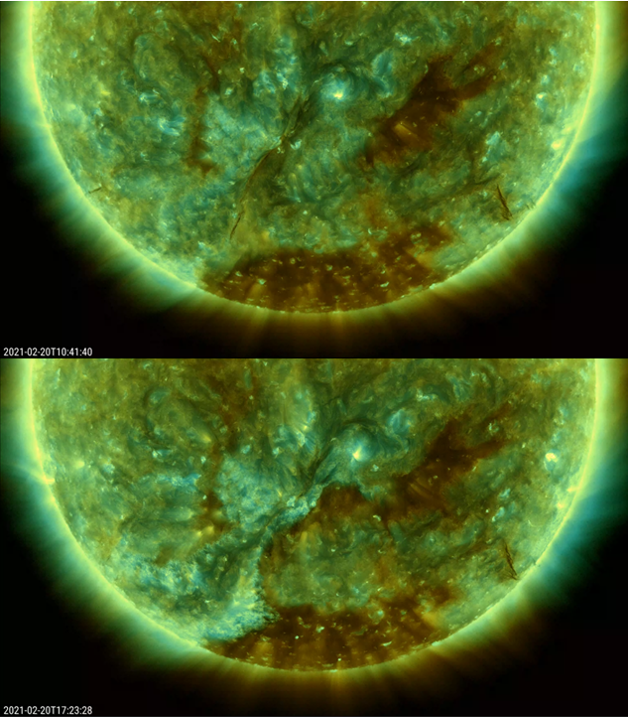
The CME from 21 February had its source in active region NOAA 2803 in the northeast solar quadrant. At the time, this was a very small sunspot group. The eruption took place near the leading portion of the region, where the SDO/AIA images (https://sdo.gsfc.nasa.gov/data/aiahmi/ ) show some coronal dimming. Interestingly, simultaneously, there was also a brief and smaller coronal dimming in the nothwest quadrant. Compared to the 20 February CME, the CME associated with the eruption in NOAA 2803 was slower, less wide and not directed to Earth. The clip also briefly shows a shadow in front of the Sun. This is the Earth eclipsing the Sun as seen from SDO. Due to its orbit, SDO undergoes a few weeks of solar eclipses by the Earth during each equinox every year (see "SDO is Go" at http://sdoisgo.blogspot.com/ ).
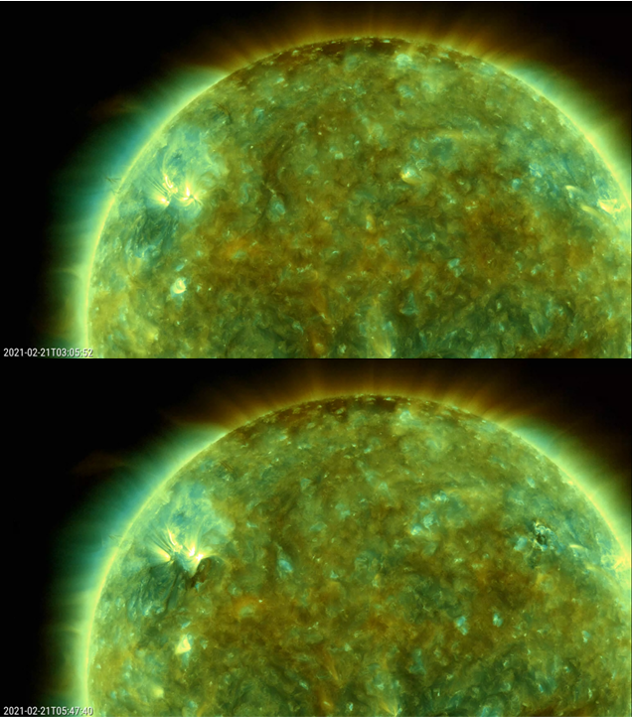
Review of solar activity
The solar activity has been mostly quiet.
Two sunspots (Catania 72 and 23, NOAA-AR 2802 and 2803) were observed on the visible solar disc. However, no significant flaring activity was recorded.
A filament located in the South-East quadrant erupted on February 16 around 14:30 UT. It was observed in the SOHO/LASCO coronagraph imagery around 15:30 UT. No Earth component was identified.
Another filament located around -15 degree longitude and -20 degree latitude erupted on February 20 around 10:00 UT. A partial-halo Coronal Mass Ejection (with and angular width of about 150 degree) was observed in SOHO/LASCO-C2 coronagraph images around 11:30 UT. The estimated CME projected speed was between 300 km/s and 500 km/s. We estimated the true speed to be higher, up to 900 km/s.
The greater than 10 MeV proton flux was at nominal level.
The greater than 2 MeV electron flux increase and passed the 1000 pfu threshold close to the end of the week due to the enhancement of the solar wind conditions.
PROBA2 Observations (15 Feb 2021 - 21 Feb 2021)
Solar Activity
Solar flare activity was very low during the week.
In order to view the activity of this week in more detail, we suggest to go to the following website from which all the daily (normal and difference) movies can be accessed: https://proba2.oma.be/ssa
This page also lists the recorded flaring events.
A weekly overview movie can be found here (SWAP week 569) http://proba2.oma.be/swap/data/mpg/movies/weekly_movies/weekly_movie_2021_02_15.mp4 .
Details about some of this week's events can be found further below.
If any of the linked movies are unavailable they can be found in the P2SC movie repository here https://proba2.oma.be/swap/data/mpg/movies/
Monday Feb 15
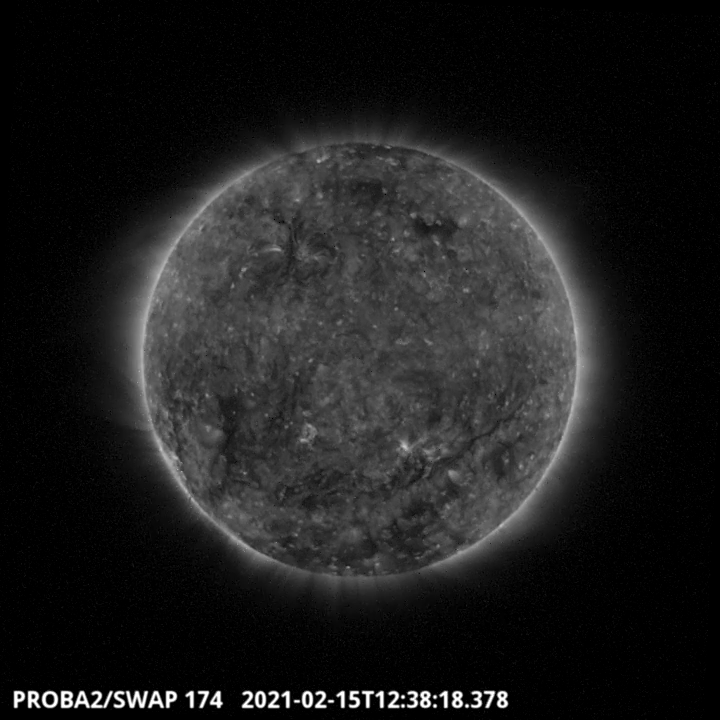
A coronal hole on the South-East part of the solar disk is visible on the SWAP image above around 12:38 UT. It has evolved during the whole week. Find a movie of the events here (SWAP movie) http://proba2.oma.be/swap/data/mpg/movies/20210215_swap_movie.mp4
Saturday Feb 20
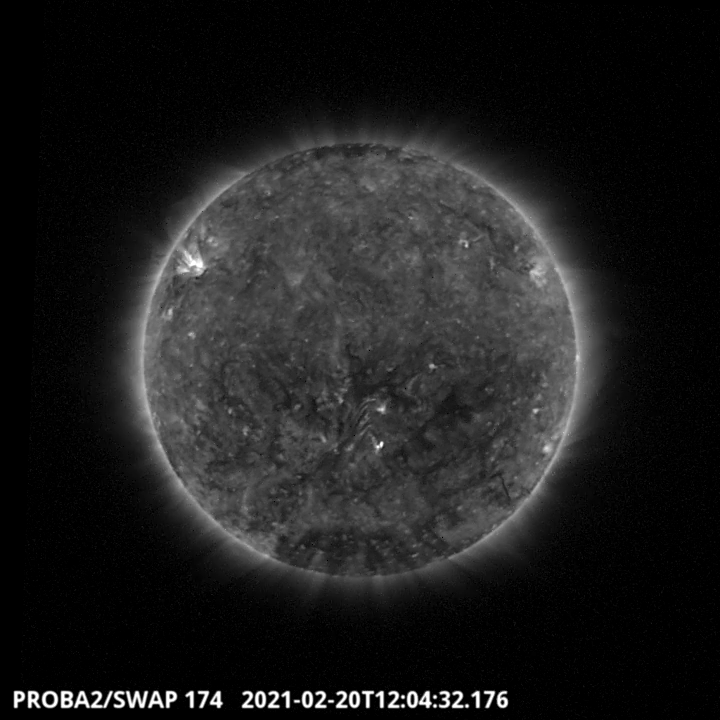
Flows are observed close to the central meridian around 12:04 UT. A CME has been recorded by CACTUS around that time, this CME followed a filament eruption. Find a movie of the events here (SWAP movie) http://proba2.oma.be/swap/data/mpg/movies/20210220_swap_movie.mp4
The International Sunspot Number by Silso
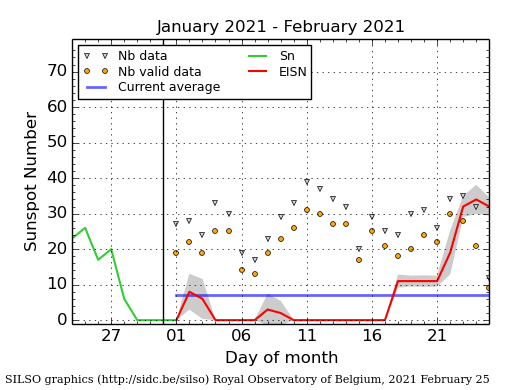
The daily Estimated International Sunspot Number (EISN, red curve with shaded error) derived by a simplified method from real-time data from the worldwide SILSO network. It extends the official Sunspot Number from the full processing of the preceding month (green line), a few days more than one solar rotation. The horizontal blue line shows the current monthly average. The yellow dots gives the number of stations that provided valid data. Valid data are used to calculate the EISN. The triangle gives the number of stations providing data. When a triangle and a yellow dot coincide, it means that all the data is used to calculate the EISN of that day.
Review of geomagnetic activity
From February 19 onwards, the Earth was under the influence of a fast solar wind. Its speed went up to 600 km/s. The total magnetic field reached 14.5 nT. The Bz component fluctuated between -10.9 nT and 10.9 nT. The high-speed stream was associated with the southern polar and the equatorial solar coronal hole (negative magnetic polarity).
The geomagnetic conditions over the past week were active.
Although, a minor storm was measured in Dourbes (K-Dourbes=5) on February 20, between 19:00 and 20:00 UTC in response to the enhancement of the solar wind parameters and prolonged periods of southward directed Bz component.
The SIDC Space Weather Briefing
The Space Weather Briefing presented by the forecaster on duty from Feb 14 to 21. It reflects in images and graphs what is written in the Solar and Geomagnetic Activity report.

A pdf-version: https://www.stce.be/briefings/20210222_SWbriefing.pdf
The movie: https://www.stce.be/briefings/20210222_SWbriefing.m4v
Review of ionospheric activity (15 Feb 2021 - 21 Feb 2021)
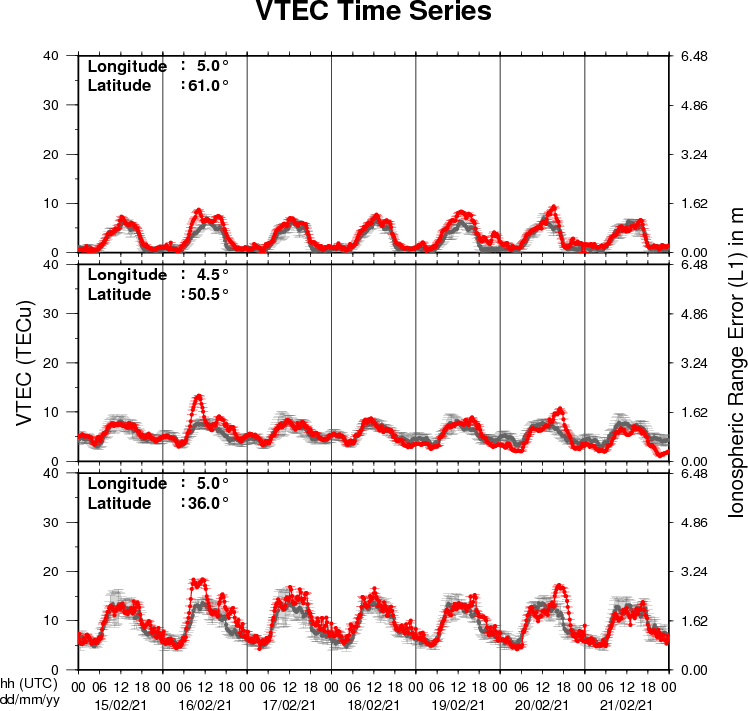
The figure shows the time evolution of the Vertical Total Electron Content (VTEC) (in red) during the last week at three locations:
a) in the northern part of Europe(N61°, 5°E)
b) above Brussels(N50.5°, 4.5°E)
c) in the southern part of Europe(N36°, 5°E)
This figure also shows (in grey) the normal ionospheric behaviour expected based on the median VTEC from the 15 previous days.
The VTEC is expressed in TECu (with TECu=10^16 electrons per square meter) and is directly related to the signal propagation delay due to the ionosphere (in figure: delay on GPS L1 frequency).
The Sun's radiation ionizes the Earth's upper atmosphere, the ionosphere, located from about 60km to 1000km above the Earth's surface.The ionization process in the ionosphere produces ions and free electrons. These electrons perturb the propagation of the GNSS (Global Navigation Satellite System) signals by inducing a so-called ionospheric delay.
See http://stce.be/newsletter/GNSS_final.pdf for some more explanations ; for detailed information, see http://gnss.be/ionosphere_tutorial.php
